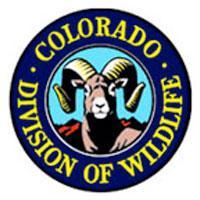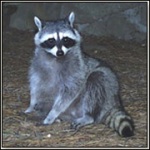Florida 11/15/11 sun-sentinel.com: by Lisa Bolivar – When Diane Pulliam saw the German shepherd-size animal hunting in her backyard, she grabbed her camera and photographed it before posting it to her Facebook page. What followed has sparked conjecture on whether the sleek-coated animal is the almost extinct eastern red wolf, or a supercharged coyote. “I thought it was a wild dog, and I had a camera so I went ahead and took the picture, but as soon as it saw me it took off,” said Pulliam, 62. Pulliam lives just west of Fort Pierce in the Ten Mile Creek area and took the photos on Nov. 5. People on her Facebook page told her the animal was a wolf, but two experts disagree on whether it is a coyote or wolf. “The photo doesn’t highlight the features that make them distinguishable between coyotes and wolves,” said David Rabon, coordinator for the Red Wolf Recovery Program with the U.S. Fish and Wildlife Service in Manteo, N.C. — the only red wolf breeding program in the country.
Red wolves used to populate most of the Eastern United States and into Texas, but have disappeared in the wild, Rabon said. Therefore, Rabon said it is highly unlikely that the animal in the photograph is a wolf, and that red wolves became extinct in the wild in the 1980s. He said there are fewer than 300 red wolves in existence, and those are in North Carolina — and that includes 170 animals in the program’s captive breeding population. Rabon said red wolves are the most endangered mammal on earth.
“Extinct? Not at all,” said Bruce Dangerfield, animal control officer with the Vero Beach Police Department, who was on the cover of the September-October issue of Animal Sheltering magazine, produced six times a year by the Humane Society of the United States. He is confident that the animal is a wolf, not a coyote. “It doesn’t have any body features of a coyote, its head and jaws are wider,” said Dangerfield, who was named the state’s top animal control officer in 2008. “A coyote has longer legs and a much lighter body.” “Who is to say someone didn’t trap one and brought it down here?” he said, adding that he has not actually seen any wolves in the wild.
 A coyote could carry red wolf genes or characteristics, Rabon said. “(Coyotes) have a mix of wolf and dog and other stuff in them here in the east,” Rabon said. “They are a mixture of all these other animals, so sometimes they get bigger and take on wolf-like characteristics.” Coyotes have expanded their range and are common, said Trish Adams of the U.S. Fish and Wildlife Service in Vero Beach. “I have had them run across (County Road) 510 on my way to work this spring,” she said. “They’ve gotten a really strong foothold, and, in fact, they’ve gotten a strong foothold in South Florida.” Adams and her co-worker Marilyn Knight, who used to work with the North Carolina Red Wolf program, said coyotes pose no threat to people, but should not be fed or approached. “They are here and they are here to stay,” Adams said, adding that the animal’s favorite foods include rabbits, mice, rats and even birds — and pet food if the food is left outside. Coyotes also have been known to kill small farm animals such as goats. Pulliam said it makes sense that the dog-like creature is a coyote. “My husband and I have noticed that we have fewer rabbits around,” she said.
A coyote could carry red wolf genes or characteristics, Rabon said. “(Coyotes) have a mix of wolf and dog and other stuff in them here in the east,” Rabon said. “They are a mixture of all these other animals, so sometimes they get bigger and take on wolf-like characteristics.” Coyotes have expanded their range and are common, said Trish Adams of the U.S. Fish and Wildlife Service in Vero Beach. “I have had them run across (County Road) 510 on my way to work this spring,” she said. “They’ve gotten a really strong foothold, and, in fact, they’ve gotten a strong foothold in South Florida.” Adams and her co-worker Marilyn Knight, who used to work with the North Carolina Red Wolf program, said coyotes pose no threat to people, but should not be fed or approached. “They are here and they are here to stay,” Adams said, adding that the animal’s favorite foods include rabbits, mice, rats and even birds — and pet food if the food is left outside. Coyotes also have been known to kill small farm animals such as goats. Pulliam said it makes sense that the dog-like creature is a coyote. “My husband and I have noticed that we have fewer rabbits around,” she said.
 Kansas 11/16/11 kwch.com: The Kansas Department of Wildlife, Parks and Tourism said Wednesday that a mountain lion was spotted on a trail in Atchison County. A deer hunter checked his trail camera and found what he believed to be a slightly blurry image of a mountain lion. After searching the area and finding large tracks, he contacted the local Kansas Department of Wildlife, Parks and Tourism (KDWPT) natural resource officer (NRO). On Thursday, Nov. 10, the NRO and a biologist investigated the site and found additional tracks, confirming the presence of a mountain lion. By measuring vegetation at the scene, they were able to estimate the size of the animal at 25 inches tall and 4.5 feet long. This is the sixth mountain lion verified
Kansas 11/16/11 kwch.com: The Kansas Department of Wildlife, Parks and Tourism said Wednesday that a mountain lion was spotted on a trail in Atchison County. A deer hunter checked his trail camera and found what he believed to be a slightly blurry image of a mountain lion. After searching the area and finding large tracks, he contacted the local Kansas Department of Wildlife, Parks and Tourism (KDWPT) natural resource officer (NRO). On Thursday, Nov. 10, the NRO and a biologist investigated the site and found additional tracks, confirming the presence of a mountain lion. By measuring vegetation at the scene, they were able to estimate the size of the animal at 25 inches tall and 4.5 feet long. This is the sixth mountain lion verified  in Kansas by KDWPT since 2007, and the third photographed by a deer hunter’s trail camera. The hunter did not wish to have the specific location disclosed but did notify neighboring residents of the mountain lion’s presence. KDWPT staff believe this animal probably dispersed from a western state and is not likely to stay in one area for more than a few days.
in Kansas by KDWPT since 2007, and the third photographed by a deer hunter’s trail camera. The hunter did not wish to have the specific location disclosed but did notify neighboring residents of the mountain lion’s presence. KDWPT staff believe this animal probably dispersed from a western state and is not likely to stay in one area for more than a few days.
 According to ongoing research by the Colorado Division of Wildlife, dispersing mountain lions, which are primarily young males, mostly feed on medium-sized animals such as raccoons, raptors, coyotes, and turkeys. They feed on deer less frequently, which take days to consume and likely hinder their movement across the landscape in search of the opposite sex and an area in which to establish a permanent home range. It is believed these dispersing mountain lions continue to travel until they are killed or they find a mate. In June, DNA tests indicated that a young male mountain lion killed in Connecticut originated in the Black Hills of South Dakota, more than 1,800 straight-line miles away.
According to ongoing research by the Colorado Division of Wildlife, dispersing mountain lions, which are primarily young males, mostly feed on medium-sized animals such as raccoons, raptors, coyotes, and turkeys. They feed on deer less frequently, which take days to consume and likely hinder their movement across the landscape in search of the opposite sex and an area in which to establish a permanent home range. It is believed these dispersing mountain lions continue to travel until they are killed or they find a mate. In June, DNA tests indicated that a young male mountain lion killed in Connecticut originated in the Black Hills of South Dakota, more than 1,800 straight-line miles away.
 Florida 11/17/11 Santa Rosa County: A raccoon that bit a dog has tested positive for rabies. The dog must be euthanized or remain under quarantine at a local vet’s facility for six months at the owner’s expense because it had not been vaccinated. See http://www.srpressgazette.com/news/rosa-14389-santa-county.html
Florida 11/17/11 Santa Rosa County: A raccoon that bit a dog has tested positive for rabies. The dog must be euthanized or remain under quarantine at a local vet’s facility for six months at the owner’s expense because it had not been vaccinated. See http://www.srpressgazette.com/news/rosa-14389-santa-county.html
 Florida 11/16/11 St. Petersburg, Pinellas County: Health officials say several children are receiving rabies treatments after handling a live bat they found at the Meadows Apartment complex, but the bat cannot be found. Parents who believe their children may have had contact with the bat are urged to call the health department at 727-824-6932 immediately. See http://oldnortheast.patch.com/articles/st-petersburg-children-may-have-been-exposed-to-rabies
Florida 11/16/11 St. Petersburg, Pinellas County: Health officials say several children are receiving rabies treatments after handling a live bat they found at the Meadows Apartment complex, but the bat cannot be found. Parents who believe their children may have had contact with the bat are urged to call the health department at 727-824-6932 immediately. See http://oldnortheast.patch.com/articles/st-petersburg-children-may-have-been-exposed-to-rabies
 Kansas 11/17/11 El Dorado, Butler County: A skunk submitted for testing by a local animal clinic has been found positive for rabies. See http://www.eldoradotimes.com/topstories/x1821247548/Skunk-tests-positive-for-rabies-first-local-case-this-year
Kansas 11/17/11 El Dorado, Butler County: A skunk submitted for testing by a local animal clinic has been found positive for rabies. See http://www.eldoradotimes.com/topstories/x1821247548/Skunk-tests-positive-for-rabies-first-local-case-this-year
 New Jersey 11/16/11 Lawrence, Mercer County: A sick raccoon curled up in a driveway on Review Avenue last week has tested positive for rabies. See http://www.centraljersey.com/articles/2011/11/16/the_lawrence_ledger/news/doc4ec42bf50465c104003068.txt
New Jersey 11/16/11 Lawrence, Mercer County: A sick raccoon curled up in a driveway on Review Avenue last week has tested positive for rabies. See http://www.centraljersey.com/articles/2011/11/16/the_lawrence_ledger/news/doc4ec42bf50465c104003068.txt
 North Carolina 11/16/11 Halifax County: Local health officials have issued a health alert after a cat tested positive for rabies. See http://www.rrdailyherald.com/news/halifax-health-department-issues-rabies-notice/article_bb81b834-10a6-11e1-a9a6-001cc4c03286.html
North Carolina 11/16/11 Halifax County: Local health officials have issued a health alert after a cat tested positive for rabies. See http://www.rrdailyherald.com/news/halifax-health-department-issues-rabies-notice/article_bb81b834-10a6-11e1-a9a6-001cc4c03286.html
 Texas 11/16/11 Plainview, Hale County: A sick skunk picked up Oct 27 has tested positive for rabies. See http://www.myplainview.com/news/article_1e8df584-1014-11e1-b640-001cc4c03286.html
Texas 11/16/11 Plainview, Hale County: A sick skunk picked up Oct 27 has tested positive for rabies. See http://www.myplainview.com/news/article_1e8df584-1014-11e1-b640-001cc4c03286.html
Follow-Up Reports:
(See November 17, 2011: RABIES reports from WISCONSIN.)
 Wisconsin 11/17/11 Manitowoc, Manitowock County: Police have located the owner of a dog that bit a woman with special needs and learned the dog is current with its rabies vaccination shots. See http://www.htrnews.com/article/20111117/MAN0101/111117070/Manitowoc-police-locate-dog-allegedly-bit-woman
Wisconsin 11/17/11 Manitowoc, Manitowock County: Police have located the owner of a dog that bit a woman with special needs and learned the dog is current with its rabies vaccination shots. See http://www.htrnews.com/article/20111117/MAN0101/111117070/Manitowoc-police-locate-dog-allegedly-bit-woman












Didn’t get a picture, but today a bobcat ran in front of my car in East Lake Woodlands, Oldsmar, Florida. What a beauty. Confirmed with others in the area that they have seen the gorgeous creature!
Based on its appearance it is a red wolf, and oddly enough there was a subspecies of red wolf found only in Florida thought to be extinct in 1921 due to hunting, Its muzzle is what distinguished it from a coyote who has a smaller more round muzzle this ,Canis Lupus, had a clear cut large square muzzle like that of a wolf , this is amazing, I’ve wanted to actually look and see if there were any remnants missed or the Florida Red Wolf and the Florida Black Wolf, the latter of the 2 was last seen in 1908.
This picture is amazing! I have been telling my husband that I keep seeing this same animal coming out of the woods behind our house several times. We live in Jacksonville Florida. This morning I watched a pack of four I truly believe are wolves come out of the woods. They walked or trotted along the water line of the retention pond behind our house and when I pulled up the blinds so my daughters and I could get a better look at them they stopped immediately turned and stared at us then ran into the woods. This is amazing, I new I wasn’t crazy and that they were far too big to be coyotes.
I have lived here in florida all my life, grew up in the woods and hunting since young….picture most likely a wolf..seen big and small coyotes none ever come close to the size of a german shepard…..until i seen one walking along my canal(live close to a large preserve here in sarasota,fl area) thought it was a coyote until its size dwarfed any coyote ive seen in twenty years…tryed to get a witness but wolf ran when i hollered…..strongly believe there red wolves in florida
I’ve lived in Florida all my 32 years, hunted most of them and have lived in the Ocala National Forest all my life. I have taken down both coyote and unfortunately red wolf, mostly due to being aneucence threat to wildlife and domestic animals. I have seen panthers, bobcats, monkeys and even the so called extinct Florida black wolf which i recently seen a pup in swamps off SR44 near NewSmyrna on 10/01/2014.
I saw an animal just like the one in the second photo of the story cross in front of me on route 40 in the Ocala National Forest on July 2, 2017. I am not an expert on wolves or foxes, but based on size and color it looked to me to be a wolf.